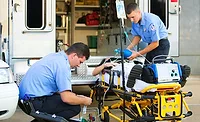We Do Need ‘Those Stinking Badges’ and More

Washington recently announced the availability of $747 million in federal anti-terror grant money, and it is being spent. The bottom line is simple – we want to be secure. We want our environment to be free from danger and risk, and free from the threat of criminal acts.
Here’s the hard part – no one wants to be inconvenienced. We balk at being searched at the airport. Relatively speaking, the United States has experienced only a small number of terrorist acts. As expected, as a nation we increased our efforts to prevent additional acts, but as the time between incidents increase, our memory seems to fade and our level of concern diminishes. Speaking as a career security professional, we really need to re-think our priorities.
I recently traveled to South America to visit Colombia, a country with a history of security issues. The U.S. State Department’s current Travel Advisory for Colombia states that “violence by narcoterrorist groups and other criminal elements continues to affect all parts of the country, urban and rural…” and continues to say, “Security is a significant concern for travelers.”
Things do seem to be improving. Violence in recent years has decreased markedly in most urban areas, including Bogotá, Medellin, Barranquilla and Cartagena. The level of violence in some areas such as Cali and its surrounding areas remains high, largely as a result of the illicit drug trade. Many rural portions of Colombia also remain extremely dangerous due to the presence of narcoterrorists and Colombian government operations against them.
People as Targets
At least five Americans were kidnapped in 2004, and at least one in 2005. Terrorist groups such as the Revolutionary Armed Forces of Colombia (FARC), the National Liberation Army (ELN) and other criminal organizations continue to kidnap civilians for ransom or as political bargaining chips. The FARC have held three American official contractors hostage since February 2003.In Colombia, security is evident everywhere. Uniformed security officers guard the doors to the local shopping mall. They inspect handbags and use handheld magnetometers to check patrons for weapons. While staying in Columbia, an armed security officer stood watch at the lobby entrance to my hotel. High walls topped with razor ribbon and electric fences surrounded housing areas.
The most evident security was at the airport. Upon arrival, you immediately notice the abundance and variety of security personnel, including airport officials, airline officials and the clear presence of the army and state police. Then you notice the large x-ray machine used to screen all inbound carry-on luggage. What I noticed was that the x-ray machine did not show an x-ray picture – but there was a confused looking technician staring blankly at a panel of wire.
The lack of equipment did not stop the attempt at security. Carry-on luggage was hand inspected, which means that the luggage that you carried off the plane is searched and gone through by the security personnel as you leave the airport.
The trip was interesting; security personnel were visibly present just about everywhere. While the news portrays Colombia as a violent country, the areas I visited, including retail stores, restaurants and businesses, were full of people. Alvaro Uribe, President of Colombia, was selected by over 60 percent of those who voted because Colombians believe Uribe can deliver more security to Colombia.
Extreme Security
Efforts to protect U.S. citizens in Colombia occasionally require measures considered extreme by U.S. standards. Between September and October of 2006, a specific threat dictated that U.S. Embassy officials as well as American citizens were prohibited from visiting all shopping malls and surrounding areas in northern Bogota.Upon arriving in Columbia, the airlines search passengers while checking in. Baggage is x-rayed (at the check-in counter), opened and searched by security. Closed packages are opened. Then passengers are searched upon entering the terminal. Carryon bags are x-rayed and inspected, and passengers step through metal detectors. Passengers are then “wanded,” by a metal detection wand, then “patted down” or “frisked” by a security officer to make sure nothing was overlooked.
Once in the airport, there is a third search prior to entering the International gate, again, carry-on bags through an x-ray machine, and a walk through a metal detector. And I’ll also note – once you’re in the gate area, no food or bathroom is available. Leaving the gate area requires going through the search process again to re-enter the gate area.
There was a high level of security. At no time did I feel unsafe while in Colombia. But how far are we willing to go to provide a secure environment?
Looking for a reprint of this article?
From high-res PDFs to custom plaques, order your copy today!



